The Long Way to a Small, Angry Planet
by Becky Chambers
[Book]
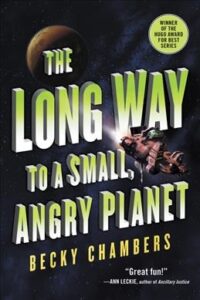
view/request
The Long Way to a Small Angry Planet begins when Ashby Santoso, the captain of a tunnelling ship, hires a young woman from Mars to be the ships first clerk. Rosemary Harper joins the ship’s small crew, which, prior to her arrival, was just the captain, the ships computer, two techs, the pilot, the navigator, an algaeist, and the kindly Dr. Chef, who serves as both the ships doctor and its chef. We see the crew through Rosemary’s eye’s as they take on an unprecedent contract which requires them to travel the long way around to a distant planet near the galactic core.
The galaxy portrayed in The Long Way to a Small Angry Planet is full of diverse and intelligent life. It’s a vision of the future much like that portrayed in Star Trek–there’s still plenty of misbehavior and conflict, but overall most folks have found ways to get along. We meet diverse intelligent species, from the lizard-like Aandrisk to the clam-like Harmagian. The tone of the book is light hearted and whimsical–it’s not as outrageous or as tongue-in-cheek as The Hitch-Hiker’s Guide to the Galaxy, but Douglas Adams fans will certainly find much to appreciate here. And, while established science fiction fans will appreciate the numerous homages to classic science fiction (I was delighted by reference to Ursula K. Le Guin and Vernor Vinge), it is also approachable for those new to science fiction.
Some may complain that The Long Way to a Small Angry Planet isn’t sufficiently profound. It doesn’t chart new territory in terms of scientific ideas or paint some novel vision of the future we have never seen before. These criticisms are valid. But it does introduce us to interesting ideas while allowing to get to know a cast of characters that we can genuinely like, and it does so while painting a refreshingly optimistic view of the future that is a pleasure to read. The Long Way to a Small Angry Planet is the first in a series, and I look forward to reading more.
Reviewed by Ben
Tagged: Fiction, Science fiction
Insomniac City: New York, Oliver, and me
by Bill Hayes
[Book]
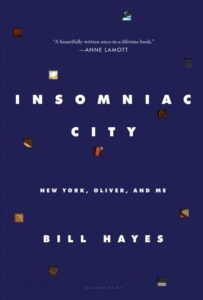
view/request
Writer and photographer Bill Hayes has written a moving memoir that is equally a love letter to New York City and an affectionate portrait of his partner, the writer and neurologist Oliver Sacks. Through vignettes and diary entries we see the city and the people in it as Hayes does and his enthusiasm and affection are infectious. It’s a particular treat to see Sacks through Hayes’s eyes: here he is revealed, yes, as a brilliant scientist and writer and as a quirky genius with eccentric habits, but, more importantly, as the brilliant scientist and quirky genius whom Hayes adores and who adores Hayes in turn. As for the city, Hayes has a remarkable ability to meet, befriend, and like the people around him, and many of the passages that are not about Hayes and Sacks are about Hayes and the folks he meets: shop owners, skateboarders, dancers, artists, many of whom he meets through his photography. The photographs in the book, even when it is not clear how they relate to the text, further enhance the experience of, again, seeing through Hayes’s eyes.
Reviewed by Ben
Tagged: LGBTQ, Memoir, New York City, Non-fiction
Race for the Galaxy
by Tom Lehmann
[Library of Things]

view/request
Build a galactic civilization! This incredibly clever and evocative card game (for 2-4 players) has you exploring, settling worlds, developing industries, and producing and trading goods. It’s a competitive game, but interactions with your fellow players are limited. There is a lot of skill involved and there are opportunities to affect your fellow players. Your resources are cards you draw from a facedown pile, so there is no competition there—but each turn you choose a phase to play, and all players get to benefit from that phase. The trick to coming out on top? Choosing phases that benefit you more than they benefit the other players! Each phase—explore, develop, settle, consume, and produce—has its uses, and the player that chose the phase gets a special bonus. It’s a fun mechanic, and one that can be quite exciting as the game nears its end—on the last turn, will you get a chance to both settle and develop? You can only choose one!
The game cards are rich with information: the cost to play them, the points they are worth, and symbols and text indicating what bonuses they give during each phase of play. The system of symbols is elegant and concise but takes some getting used to—the game comes with a large reference card for each player that you will find useful when learning the game, in time you will realize you don’t need it any longer, but it is invaluable when learning the game. The game cards also have wonderful art which I continue to enjoy game after game.
One of the best things about this game is its simple mechanisms and setup. There are only two components: cards, and victory point tokens. Victory point tokens represent extra points at game end. Cards are multipurpose and represent everything else in the game. Cards are your currency—you discard cards from hand to pay for things. Cards are your worlds and developments—when you settle or develop you pay the cost and place the card in front of you, adding it to your civilization. And cards are the goods produced by industry and traded in commerce—a card placed under a world is a good which you can trade (discard to draw more cards into your hand) or consume (discard to draw more cards or gain victory point tokens).
It’s also a pretty quick game once you are familiar with it. My girlfriend and I play often, and we almost always play multiple games in a sitting. Why not? The game is out, quick to setup, quick to play, and it’s lots of fun!
Reviewed by Ben
Tagged: Board games, Game, Science fiction, Strategy
Century Spice Road
by Emerson Matsuuchi
[Library of Things]
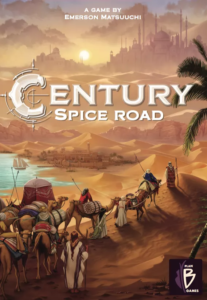
view/request
Century Spice Road is a wonderfully simple and compelling game for 2-5 players. I love it. Here are some of the best things about it:
- Setup is quick–not much more than just shuffling two decks of cards and counting out a few tokens
- The game is easy to learn and quick to play
- The competition is low key
- The art on the cards is beautiful and the pieces (wooden cubes, metal coins, and plastic bowls) are tactilely satisfying
- It’s a deck building game of sorts, but it is refreshingly different from other deck building games I’ve played
- The gameplay is fun whether you win or lose
The premise is that you are a merchant, trading in spices. There are four types of spices in the game, each represented by wooden cubes of a specific color: yellow for turmeric, red for cayenne, green for cardamon, and brown for cinnamon. Market cards let you acquire or trade spices and spices can be traded for victory point cards. The trick is that you must have the have the right spices to pay the card’s cost. That victory card that is worth 20 points may be very tempting, but how are you going to obtain the five cinnamon cubes necessary to pay for it?
Everyone starts out with the same two market cards and a few cubes of turmeric and players compete to acquire market cards and victory point cards from an ever changing supply–each time someone acquires a card the cards to the right of it are slid left and a new card is dealt in the rightmost spot. Some clever mechanics ensure that their is generally an incentive to acquire the leftmost cards (the leftmost victory cards come with coins for bonus points and the leftmost market cards cost the least) which encourages turnover in the supply.
The gameplay can vary a great deal from game to game and there is no one winning strategy. Do you have a good way of obtaining new spices? Are your trades efficient? Are you able to easily obtain any spice you need or do you find yourself with a glut of cayenne or turmeric without a good way of obtaining the other spices you need? It’s different every game.
I very much Century Spice Road. Borrow it from the library and give it a try!
Reviewed by Ben
Tagged: Board games, Game, Strategy
The Big Over Easy
by Jasper Fforde
[Book]
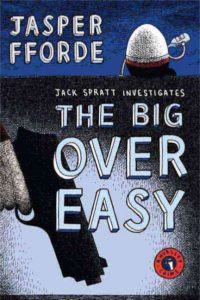
view/request
The Big Over Easy is a nonsensical but compelling police procedural. Detective Inspector Jack Spratt heads the Nursery Crimes Division, an underfunded and overworked department of the Reading Police Department, with jurisdiction over People of Dubious Reality. In this alternate universe, Reading, Berkshire, is home to a not insignificant number of characters from nursery rhymes, fables, fairy tales, and the like. From the the three little pigs to Old Mother Hubbard and a substantial number of woodcutters and millers’ sons, Reading is full of folks whose identities as storybook characters are obvious to everyone but themselves.
The story begins when Sergeant Mary Mary is assigned to work with DI Spratt on what seems a straightforward case: Humperdinck Jehoshaphat Aloysius Stuyvesant van Dumpty has fallen off a wall. Their investigation soon reveals, however, that Humpty’s death was anything but accidental. Forensics quickly reveals that Humpty was shot, but further conclusions are harder to come by due to the lack of ballistics research on large egg. Inquiries into Humpty’s past reveal all sorts of shady dealings, including involvement in a straw-into-gold racket. And interviews with Solomon Grundy, Rapunzel, and Wee Willie Winkie bring up more questions than answers.
The Big Over Easy is a delightful read, prefect for when you want something both clever and silly.
Reviewed by Ben
Tagged: Fantasy, Fiction, Humor, Mystery, Police procedural
First Person Singular
by Haruki Murakami
[Book]

view/request
This small collection of eight short stories by Haruki Murakami has everything I love about Murakami’s writing: the subtle oddness, the evocative descriptions of ordinary things, his expansive awareness of culture and great enthusiasm for favored subjects from baseball to jazz. Each story here is written in the first person, from the perspective a man, usually a middle-aged writer, examining some past experience. Many of the stories are completely realistic, with a few leaving you wondering whether they might be autobiographical. In one the narrator is even an author named Haruki Murakami! In others, the stories are subtly fantastic: the narrator reflects on the time he met a talking monkey at a hot spring; the narrator finds himself in another man’s body, perhaps. And, in typical Murakami fashion, even some of the most realistic stories leave you perplexed, like the narrator, wondering just what might have been going on.
My favorite story in the collection is, without a doubt, “The Yakult Swallows Poetry Collection”—the story with a narrator named Haruki Murakami that reads so much like memoir. In it the narrator tells us of his love of baseball, how he came to become a Yakult Swallows fan, and how, early in his career, he self-published a chapbook of poems about baseball. The story includes a number of delightful poems about baseball (you need not be a baseball fan to appreciate them) and is told in a pleasantly conversational tone. There is no strangeness in this story, except for the mundane strangeness that lies at its very heart—why would a man be a fan of such a losing team?
This is a great volume for fans of short stories. It is sure to delight established Murakami fans, and would be a great introduction to his work for anyone not yet familiar with his writing.
Translated from the Japanese by longtime Murakami translator Philip Gabriel.
Reviewed by Ben
Tagged: Fiction, Japan, Magical realism, Short stories
The Man Who Lived Underground
by Richard Wright
[Book]

view/request
In 1940, Richard Wright had a best seller with his first published novel Native Son. Soon after he began work on another novel, The Man Who Lived Underground, of which he wrote “I have never written anything in my life that stemmed more from sheer inspiration”. This novel, which combines elements of realism, surrealism, and allegory (or at least something allegory adjacent), tells the story of a black man falsely accused of a murdering a white couple. He is violently interrogated by a trio of brutish police detectives, forced to sign a confession, and flees through the sewers and becomes “the man who lived underground”, an experience which changes him profoundly.
The Man Who Lived Underground would not be published as a novel in Wright’s lifetime—a much abbreviated version was published as a short story in 1942—but this year, in cooperation with Wright’s estate, Library of America has published the novel in its entirety, and it is well worth reading.
The novel is published together with an essay by the author, “Memories of My Grandmother”, in which he explains his writing process, inspiration, and intent in the novel. It’s fascinating and completely changed how I perceived the text. There’s also a short afterword by Malcolm Wright, the author’s grandson, which provides further context.
Highly recommend for anyone interested in Wright, African-American literature, or race and racism in the United States.
Reviewed by Ben
Tagged: Fiction, Race, Racism
All Systems Red
by Martha Wells
[Book]
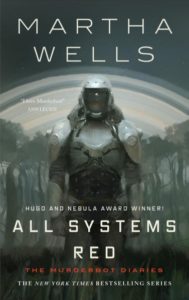
view/request
A charming story about a heavily weaponized semi-biological robot that calls itself “Murderbot”? Yes! An armed and armored security unit that has hacked its governor-module allowing it to act independently may sound like the terrifying killer robot from a “kill all humans” story from the age of classic sci-fi, but in Martha Wells’ Murderbot Diaries the AI in question is an awkward and kind-hearted, if incredibly sarcastic and anti-social, hero of an extended coming-of-age story. Murderbot just wants to be left alone to enjoy its favorite serials on the entertainment feed, but life keeps getting in the way and in the process Murderbot grows as a person, forming relationships and learning more about what it means to be alive than it could ever know from The Rise and Fall of Sanctuary Moon or Timestream Defenders Orion.
The series begins with All Systems Red, a short novella that introduces Murderbot and some of the key humans who will play a part in its life. The series continues with Artificial Condition and is now a series of six books, with more on the way. Highly recommended.
Reviewed by Ben
Tagged: Action, Coming-of-age, Fiction, Humor, Science fiction
The 99% Invisible City: A Field Guide to the Hidden World of Everyday Design
by Roman Mars and Kurt Kohlstedt
[Book]
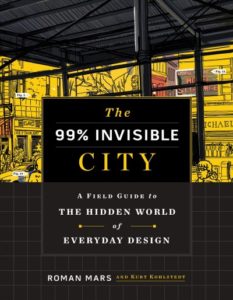
view/request
If you are interested in the world around you—what are those little boxes on the sides of buildings? why are signposts built the way they are? what do those symbols painted on the road mean?—then 99% Invisible will appeal to you. Faith has already written up the 99% Invisible Podcast as a staff pick here, but I would like to bring your attention to the book, The 99% Invisible City. The book, as its title implies, has a narrower scope than the podcast, and concentrates on the urban environment. I highly recommend it for anyone who has enjoyed episodes of the podcast or has heard about it and been intrigued but never given it a listen. Nearly all of the topics in the book have been extensively covered on the podcast, so you will actually get more out of this if you are not yet a diehard 99pi fan, though longtime listeners will certainly find it an entertaining review.
This is a great book for whetting your appetite—each topic is covered only briefly, and you will want to learn more! Perhaps its greatest deficit is the lack of photographs—the illustrations are charming, but more often than not you will want to see photographs of what has been described. If you are anything like me you will take note of those stories that intrigue you most and continue to investigate them further on your own—which is, I suspect, exactly what Roman Mars and Kurt Kohlstedt want!
Reviewed by Ben
Tagged: Design, Non-fiction
Gideon the Ninth
by Tamsyn Muir
[Book]
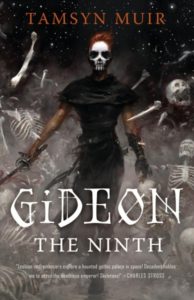
view/request
Gideon the Ninth is a dark fantasy. The world in which it is set seems to be the decaying remanent of a once prosperous interplanetary empire, but don’t let the occasional space ship fool you—this isn’t science fiction and the physics of this world are very different from our own in one notable way: some individuals are born with necromantic abilities and can learn to manipulate, blood, bone, and even the souls of the dead. This would be unbearably dark and gruesome were it not for a few things:
- Our protagonist, Gideon, is strong, queer, contrary, and absolutely hilarious. Despite all her complexities and her own dark past it is her irreverence that keeps the book from being too dark.
- The relationships are complex and intriguing. It quickly becomes clear that while Gideon may put on a show of hating everyone and everything, in actuality her feelings are rarely so simple. It should be noted that some of the relationships portrayed in this book seem deeply unhealthy—but they are also interesting and too believable to be simply dismissed.
- There is a murder mystery—with a small closed circle of suspects, mostly unknown to each other, and all brought together by unsolicited invitations we are treated to a peculiarly mystery that has something of the feel of a classic country house mystery, just with more skeletons and swordfighting.
- The book is full of details that make its world feel much larger than what is revealed. We might suppose that Gideon and her companions have some idea of the history of the once prosperous empire, but it is clear that even their understanding is incomplete and the reader is left to imagine what might have happened. And when it comes to understanding necromancy, we get a glimpse here and there of the complex rules that seem to govern it, but we soon see that even those in the book that profess to understand it best have much to learn.
- Finally, a word must be put in about the swordfighting. Very early in the book we learn that Gideon is very proficient with a two-handed longsword, but circumstances will requirer her to play the part of a cavalier, convincing her audience that she has always trained with a rapier. Muir could easily have left it at that, but she clearly did her homework, and it shows in every mention tactics, posture, and training. These descriptions of swordwork feel real and they serve to ground the fantasy.
So, yeah. I kind of loved this book. It is crass, violent, and excessively gory, but its also good, for all the reasons I gave above and probably for many more I’m not clever enough to put my finger on. This is definitely not the right book for everyone, but if the above sounds appealing, I urge you to give it a try.
Reviewed by Ben
Tagged: Fantasy, Fiction, Humor, LGBTQ
Motl the Cantor’s Son
by Sholem Aleichem
[Book]

view/request
Motl the Cantor’s Son was the last novel by Sholem Aleichem. It tells the story of Motl and his family, first in Kasrilevke, a fiction shtetl where the family is increasingly destitute after the death of Motl’s father Peysi, then on their journey as refugees across Europe and eventually by boat to America, and finally as they try to assimilate and make a living in New York.
Although the story is full of hardships, Motl sees the changes in his circumstances in an entirely positive light. When his father dies, Motl enjoys the attention he receives and hardly seems aware of the death as a loss, and when family must sell all their furniture, Motl delights in how much space they now have. Motl generally sees the world around him as a great source of humor and amusement—he certainly isn’t bothered by the worries—mostly about money and social status—that preoccupy the adults around him. And Motl and his family, in fact, are lucky compared to many of their neighbors—his family leaves because of economic hardship, but those that stay are soon forced out by a pogrom.
Sholem Aleichem never finished the novel. We don’t know what eventually becomes of Motl and his family in New York. But we do know that Motl loves his new home, and his family, after a difficult start, is doing well for themselves. More importantly, Aleichem’s storytelling is wonderfully engaging—I enjoyed every moment of them immensely.
Reviewed by Ben
Tagged: Fiction, Historical fiction, Immigration, Jewish humor
Levar Burton Reads
by Levar Burton
[Online Resource]
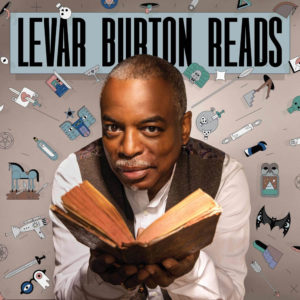
view/request
Levar Burton’s podcast has a tagline that embraces superlatives: “The Best Short Fiction, Handpicked by the Best Voice in Podcasting”. That may be taking things a bit far, but I am loving the stories Levar picks, and I can’t think of anyone I would rather hear read them. Perhaps that’s because I grew up on Reading Rainbow, but whatever your generation, if you enjoy short fiction read allowed, I urge you to check out Levar Burton Reads.
The podcast is impeccably produced, with sparing use of subtle soundscapes that enhance the storytelling. The stories are mostly science fiction and fantasy, but the selections are always of an accessible sort—you don’t need to be a fan of these genres to appreciate these well-told tales. And the authors are diverse, including both classic well-established writers and new writers of all races and genders. Levar always takes a brief moment to tell you about why he selected the story and what it means to him, and I invariably find I appreciate what he has to say.
So, whether you are looking for new authors and ideas, some great bed time stories, an impeccably produced podcast, or just the comfort of hearing Levar’s voice, give it a listen.
Reviewed by Ben
Tagged: Fantasy, Fiction, Podcast, Science fiction, Short stories












